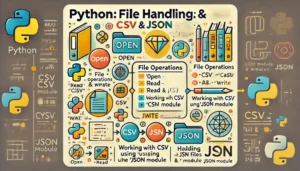Effective file handling in Python—especially reading and writing CSV and JSON files—is essential for managing data interchange between applications, performing data analysis, and automating workflows. Understanding these file operations allows developers and data analysts to efficiently store, retrieve, and process structured data. CSV files are particularly useful for tabular data, such as spreadsheets or database exports, while JSON files excel at handling hierarchical data structures common in web applications and APIs.
Mastering file handling using Python’s built-in libraries like csv and json, alongside context managers, ensures robust and efficient data management. This exercise series provides hands-on practice, equipping you with skills crucial for modern data-driven tasks.
🚀 Jump Right to Exercise Tasks: Python Exercises – File Handling (CSV, JSON)
Writing and Reading Text Files in Python
Python makes reading and writing text files straightforward. Using built-in methods like open(), you can quickly store and retrieve data. File handling involves specifying file modes like read (‘r’) or write (‘w’), and context managers (using with) help manage file resources efficiently by automatically closing files.
Practical Example
Suppose you need to store a simple greeting in a file:
with open('example.txt', 'w') as file:
file.write('Hello, Python!')
with open('example.txt', 'r') as file:
content = file.read()
print(content)Example Solution:
Hello, Python!Key Takeaways:
- Use
withto ensure automatic resource management. - Select appropriate file modes (‘r’, ‘w’, ‘a’).
- Efficiently read and write textual data.
Handling CSV Files with Python
The csv module simplifies handling CSV files, providing reader and writer objects that manage comma-separated data seamlessly. Ideal for spreadsheet-like data, Python’s CSV operations enable easy export and import of tabular data, crucial in data analysis workflows.
Practical Example
Imagine creating a CSV file containing a header and some data rows:
import csv
with open('data.csv', 'w', newline='') as file:
writer = csv.writer(file)
writer.writerow(['Name', 'Age'])
writer.writerow(['Alice', 30])
with open('data.csv', 'r') as file:
reader = csv.reader(file)
for row in reader:
print(row)Example Solution:
['Name', 'Age']
['Alice', '30']Key Takeaways:
- Easily read and write structured tabular data.
- Use
csv.writerandcsv.readerfor CSV files. - Ideal for data exchange with Excel or databases.
Working with JSON Data in Python
JSON (JavaScript Object Notation) is a popular format for data interchange between web applications. Python’s json module provides easy methods to parse JSON strings and convert Python data structures into JSON format. This capability is crucial for web development, APIs, and configuration management.
Practical Example
Suppose you want to convert a Python dictionary into JSON format and then read it back:
import json
data = {'name': 'Alice', 'age': 30}
# Writing JSON
with open('data.json', 'w') as file:
json.dump(data, file)
# Reading JSON
with open('data.json', 'r') as file:
loaded_data = json.load(file)
print(loaded_data)Example Solution:
{'name': 'Alice', 'age': 30}Key Takeaways:
- Quickly encode and decode JSON data.
- Facilitate easy data exchange with web services.
- JSON is lightweight and human-readable.
What You’ll Gain from Completing This Exercise
By practicing these Python file handling tasks, you’ll enhance your skills in managing text, CSV, and JSON files effectively. You’ll become adept at performing common data storage and retrieval operations, essential for data analysis, automation, and web development tasks.
How to Complete the Exercise Tasks
Use the interactive Python editor provided below each task:
- Write your Python code: Enter your script into the editor.
- Run your script: Click “Run” to execute and review the output.
- Verify correctness: Check results against provided test cases.
- Reset the editor: Click “Reset” to clear and start fresh.
Earn XP, Unlock Rewards, and Track Progress!
If logged in, each completed task earns XP, unlocking new levels, Avatars, and Frames. Track your progress effortlessly and climb the leaderboard!


